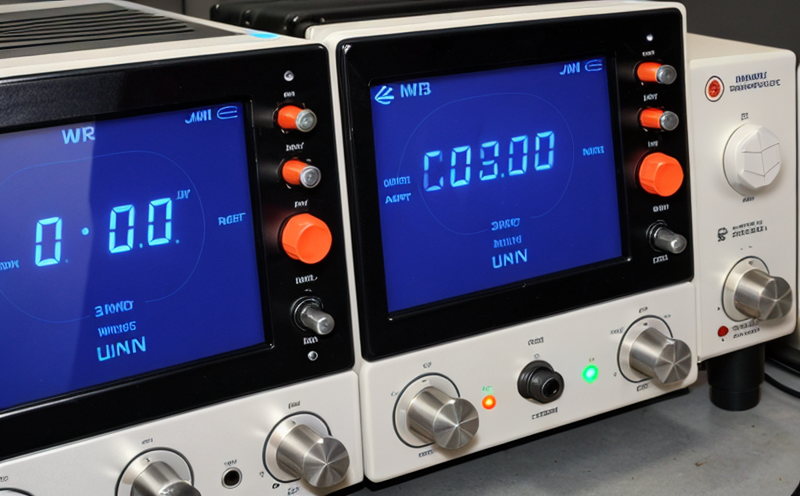EN 303 340 Digital TV RF Signal Interference Testing
The European Standard EN 303 340 is pivotal for ensuring that digital television (DTV) devices and systems are free from harmful interference, which can degrade performance or cause signal loss. This standard mandates rigorous testing to evaluate the ability of DTV equipment to operate without causing unacceptable interference to other services in the frequency band. Compliance with this regulation is mandatory for any product intended for sale within the European Union.
The process involves simulating real-world conditions that may expose the device under test (DUT) to various RF signals, including those from neighboring channels, broadcast transmitters, and other electronic devices operating in the same or adjacent frequency bands. The primary goal is to assess whether the DUT can function properly within the specified interference limits without causing unacceptable degradation.
The testing procedure typically includes multiple stages, each designed to simulate specific scenarios that a device might encounter during its lifecycle. This ensures comprehensive evaluation of the product's performance across different environments and use cases. The testing environment is meticulously controlled to replicate real-world conditions as closely as possible, incorporating factors such as signal strength, frequency overlap, and environmental noise.
One of the key challenges in this type of testing lies in accurately reproducing the complex interference patterns that can occur in residential or commercial settings. This necessitates sophisticated equipment capable of generating a wide range of RF signals and measuring their interaction with the DUT. Advanced signal generators, spectrum analyzers, and network analyzers are often employed to ensure precise control over test parameters.
The testing process also involves detailed documentation and reporting, which must adhere to strict guidelines outlined in EN 303 340. This includes not only the results of the interference tests but also an analysis of potential sources of interference and recommendations for mitigating any identified issues. The comprehensive nature of this service ensures that all relevant aspects of RF performance are covered, providing manufacturers with valuable insights into their product's suitability for deployment in a wide range of environments.
Manufacturers seeking to comply with EN 303 340 must consider the broader implications of non-compliance. Failure to meet these stringent requirements can result in significant financial and reputational damage, including legal action from affected parties or regulatory bodies. Additionally, the standard ensures that consumers receive high-quality products that are reliable and safe for use.
Given the complexity of RF interference testing, it is crucial for manufacturers to work with experienced laboratories like ours, which possess the necessary expertise and equipment to conduct these tests accurately and efficiently. Our team of professionals can provide guidance throughout the process, ensuring that all aspects of compliance are addressed thoroughly. This service not only helps companies avoid costly penalties but also enhances their reputation by demonstrating commitment to quality and consumer safety.
Scope and Methodology
The scope of EN 303 340 digital TV RF signal interference testing encompasses the evaluation of DTV equipment’s ability to operate without causing unacceptable interference to other services in the frequency band. This includes assessing the device's performance under various interference scenarios, such as those caused by neighboring channels or broadcast transmitters.
The methodology for conducting these tests involves several key steps, each designed to simulate real-world conditions that a DTV device might encounter during its lifecycle. These include:
- Setting up the test environment with controlled RF signals.
- Measuring the interference caused by the DUT under specified conditions.
- Evaluating the performance of the DUT in the presence of interference.
- Documenting and reporting the results according to EN 303 340 standards.
The testing process is further detailed by specific parameters that must be met, including signal strength, frequency overlap, and environmental noise. The use of advanced equipment such as signal generators, spectrum analyzers, and network analyzers ensures precise control over test conditions.
Industry Applications
| Application Area | Description |
|---|---|
| Digital TV Broadcasters | Evaluating the impact of interference on broadcast quality. |
| Consumer Electronics Manufacturers | Ensuring compliance with RF interference standards for new products. |
| Retailers and Distributors | Verifying product conformity before sale or distribution. |
| Regulatory Bodies | Monitoring compliance with RF interference regulations. |
| Consumer Advocacy Groups | Testing products for potential harmful interference to other services. |
Customer Impact and Satisfaction
By adhering to the stringent requirements of EN 303 340, manufacturers can significantly enhance their product quality and market reputation. Compliance with this standard ensures that digital TV devices are reliable and safe for use, which is crucial in maintaining consumer trust and satisfaction.
The rigorous testing process not only helps companies avoid costly penalties but also provides valuable insights into potential sources of interference and recommendations for mitigation strategies. This proactive approach can lead to product improvements, increased customer confidence, and enhanced market competitiveness.
In addition to the technical benefits, compliance with EN 303 340 also contributes positively to a company's reputation among stakeholders such as regulatory bodies, retailers, and consumer advocacy groups. Demonstrating commitment to quality and safety can lead to better relationships with these entities and ultimately contribute to overall customer satisfaction.
The comprehensive nature of our testing service ensures that all relevant aspects of RF performance are covered, providing manufacturers with a clear understanding of their product's suitability for deployment in various environments. This level of assurance is critical for maintaining high standards of quality and reliability in the digital TV industry.





